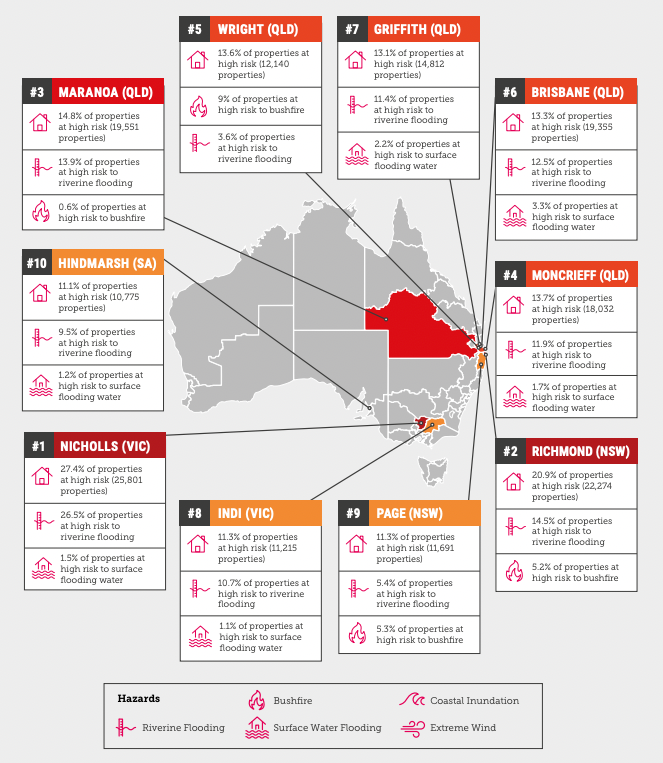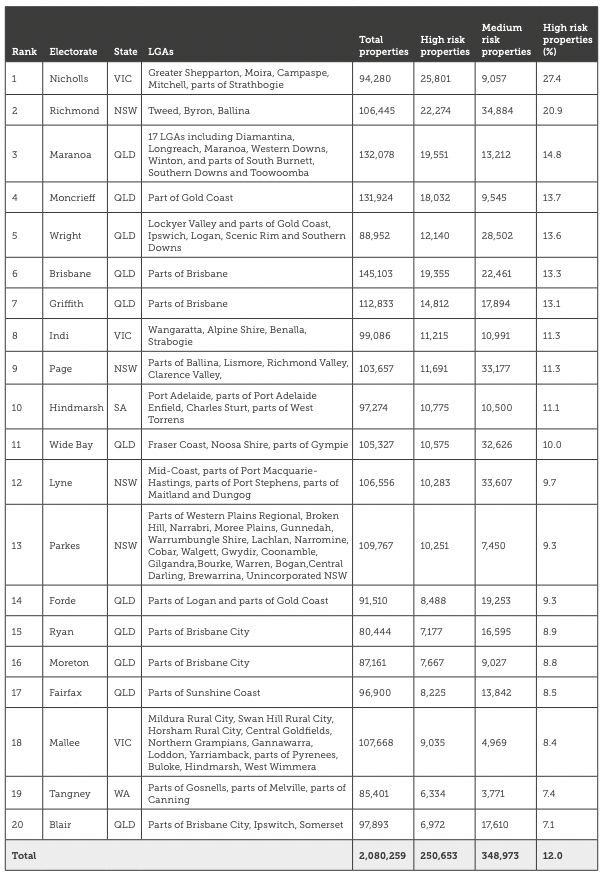New research from the Climate Council shows that one in 25 Australian properties are at high risk of being effectively uninsurable by 2030 due to the rising threat of flooding, bushfires and extreme winds.
The predictions are even worse for the recently flood-hit electorates of Brisbane and Page in NSW (which includes Lismore and Richmond Valley) where one in seven homes will be uninsurable.
Titled Uninsuarable Nation: Australia's Most Climate-Vulnerable Places, the report warns climate change is “creating an insurability crisis” in Australia and found that riverine flooding poses a threat to 80 per cent of the 250,653 properties classed high risk by 2030.
“Climate change is playing out in real-time here and many Australians now find it impossible to insure their homes and businesses,” Climate Council CEO Amanda McKenzie said.
“Over the past eight years the federal government has failed to meaningfully tackle climate change or prepare Australians for the worsening extreme weather events that we are now experiencing.
“Pollution from coal, oil and gas must begin to plummet and we must scale up our renewable power so it meets the needs of all sectors of our economy.”
Queensland is expected to be the most impacted state, with 193,232 properties (or 6.5 per cent of total properties) considered to be at high risk of uninsurability by 2030. This is followed by New South Wales with 148,536 properties (3.3. per cent) and South Australia with 35,285 properties (3.2 per cent).

The report found the most at-risk properties to be in the NSW electorate of Nicholls, where 24,976 properties - or 27.4 per cent of total homes - could be damaged by extreme weather.
Between 80 per cent to 90 per cent of homes in localities such as Shepparton, Shepparton North, Kialla, and Kialla West are likely to be uninsurable as rivers supporting agriculture present the risk of flooding. One such example is the Goulburn River, which has flooded a total of ten times between 1916 and 2012.
Coming in as the second most at-risk electorate is Richmond, which includes towns such as Ballina, Brunswick Heads, Byron Bay and Tweed Heads. The area both faces the threat of flooding from the Richmond River and inland bushfires in suburbs like Main Arm and Mount Warning.
The report also determined other high-risk local-government areas (LGAs) to be in Queensland's Diamantina, Longreach, Maranoa, and Western Downs, as well as parts of the Gold Coast and Port Macquarie in New South Wales.
“It is clear that Australia is fast becoming an uninsurable nation. Skyrocketing costs or flat-out insurance ineligibility are becoming more and more widespread under climate change,” said Climate Council councillor Nicki Hutley.
“As an economist, I find these new numbers shocking and deeply concerning.
“I urge all Australians to use this tool to understand the risk they and their communities face as we progress through this critical make or break climate decade.”
To combat the risk of climate change, the Climate Council is calling on all federal political parties to adopt policies that will see national emissions reduce by 75 per cent compared to 2005 levels by 2030.
The organisation is also pushing to see improved policies which prevent the construction of buildings and infrastructure in areas that currently are or will be highly exposed to climate change hazards.
The Climate Council’s findings come almost two months after the Insurance Council of Australia (ICA) reported more than 86,000 insurance claims had been lodged in response to the intense flooding in Queensland and NSW.
“Unless we rapidly and drastically cut greenhouse gas emissions this decade – aligned with a path to limit the global average temperature rise to well below 2°C – extreme weather will get much, much worse,” the Climate Council said.
“As a wealthy nation with a remarkable abundance of renewable energy resources and critical minerals, Australia has boundless potential to become an economic powerhouse in a world that is racing towards net zero.”
“If Australia moves quickly, we have the opportunity to drastically reduce emissions, save money through reduced fuel and power bills, boost economic growth, generate tens of thousands of additional jobs and translate our renewable energy resources into clean energy export industries worth hundreds of billions per annum.”

Get our daily business news
Sign up to our free email news updates.

)
)
)
)
)
)

